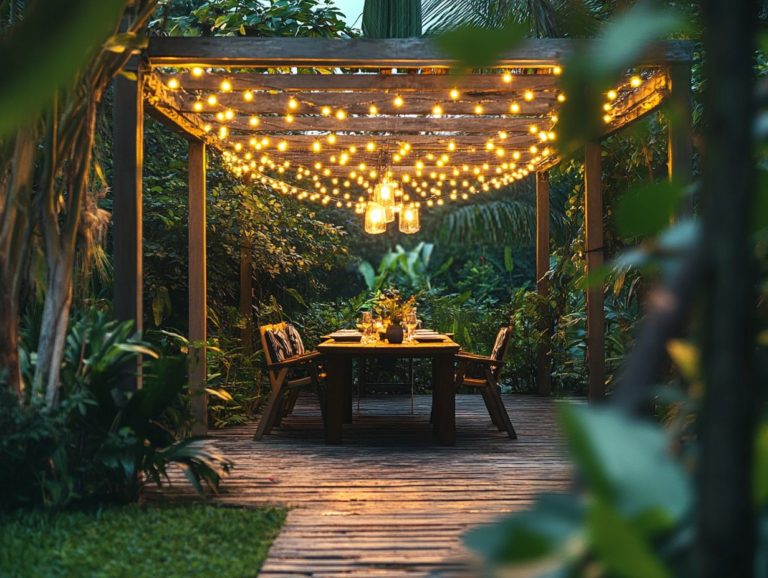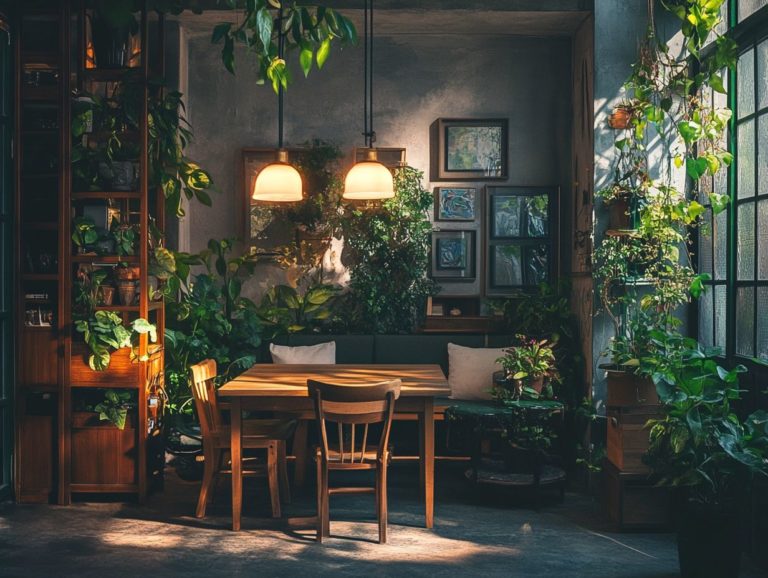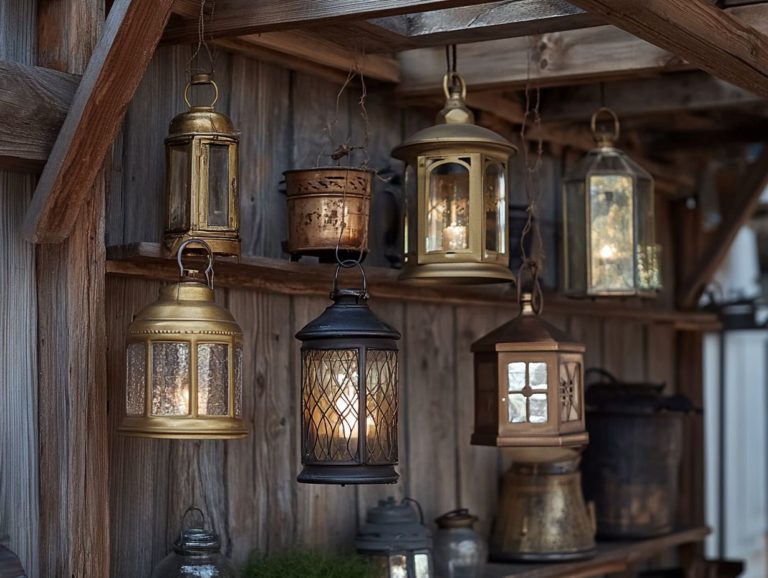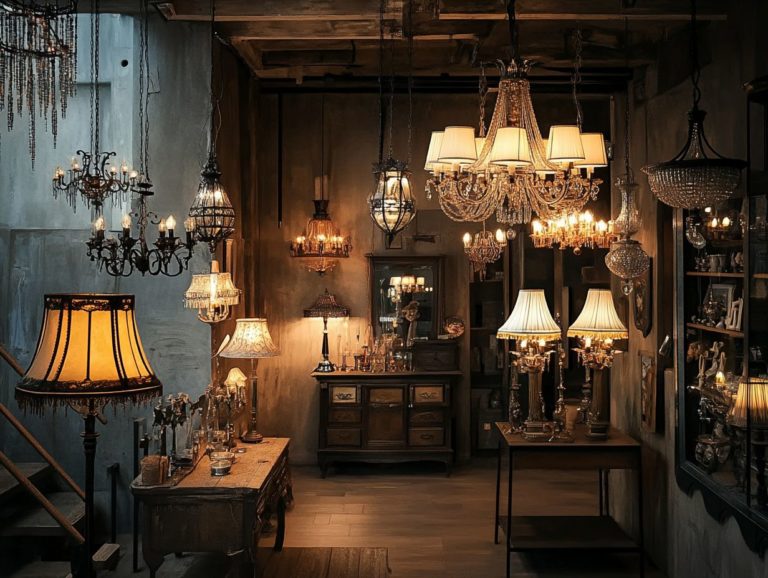Understanding Vintage Lamp Materials
Vintage lamps do more than light up a room; they tell stories and spark joy! They embody craftsmanship, styles, and tales from a bygone era.
This exploration delves into what truly qualifies a lamp as “vintage.” It emphasizes the rich materials glass, metal, ceramic, and wood that define these timeless treasures.
You’ll discover essential factors to consider when selecting a vintage lamp. We will examine aspects from design to condition and functionality.
You will learn how to care for and preserve these exquisite artifacts, ensuring their enchanting glow lasts for generations to come.
Contents
Key Takeaways:

- Vintage lamps can be made from various materials including glass, metal, ceramic, wood, and others.
- When choosing a vintage lamp, consider its style, condition, authenticity, and functionality for both aesthetic and safety reasons.
- To maintain the value and beauty of vintage lamps, proper cleaning and preservation techniques should be used.
Discover What Defines a Vintage Lamp!
A vintage lamp captures your attention with its exceptional craftsmanship and historical charm. These lamps often hail from specific design movements like Art Deco or Victorian styles. They evoke a sense of nostalgia and boast intricate details that reflect the era in which they were crafted, making them highly sought-after treasures for antique collectors and enthusiasts alike.
When identifying a vintage lamp, consider various factors, including the materials, design, and any distinctive maker s marks that reveal its history.
Well-crafted vintage lamps often use materials like brass, glass, and ceramic. Each adds to their charm and quality. As you explore, you might notice unique details like hand-painted finishes and ornate bases that set them apart from modern lighting options.
Beyond the visual allure, examining maker s marks or labels can offer valuable insights into the lamp s history and background.
Recognizing these elements deepens your appreciation for the craftsmanship involved. It also equips you to differentiate authentic vintage pieces from contemporary reproductions. Collectors often cherish specific eras or styles, valuing the stories and artistry that each unique lamp carries.
Common Materials Used in Vintage Lamps
Vintage lamps are crafted from a diverse array of materials. Each adds to their distinctive charm and functional grace. You ll often find glass, which may be intricately designed or elegantly hand-blown. Metals like brass and bronze are celebrated for their durability and the beautiful patina they develop over time. Ceramics bring vibrant hues to life, while wood imparts warmth and character to the overall design.
Your choice of materials plays a crucial role in determining a lamp’s authenticity and value, making this knowledge essential for collectors and enthusiasts alike.
Glass
Glass is an essential material in vintage lamps. It’s revered for its versatility and ability to showcase intricate designs, especially in iconic styles like Tiffany lamps and Art Nouveau. The craftsmanship in glasswork ranges from delicate stained glass patterns to bold, cut glass designs. Each adds a unique vintage charm that enhances the lamp’s overall aesthetics and elegance.
This versatility allows vintage lamps to embody various design movements, from the graceful curves of Art Nouveau to the geometric precision of the Arts and Crafts style. Each piece’s glass evokes nostalgia, drawing from the historical context of its era. Master artisans select and blend colors, creating pieces that illuminate a space while serving as engaging conversation starters.
Incorporating glass into lamp construction celebrates not just the functional aspect of lighting but also the artistry and heritage behind these timeless fixtures. This makes them prized possessions for collectors and enthusiasts alike.
Metal
Metal is a crucial element in vintage lamps. Brass and bronze are loved for their durability and timeless appeal. These metals give strong support to electric lamps and develop a stunning patina over time, which enhances their vintage authenticity and charm. This transformation makes them highly sought after by discerning lamp collectors.
The warmth of copper brings a unique glow that can redefine the ambiance of any space. On the other hand, iron is often chosen for bases due to its sturdy nature, ensuring the lamp remains stable and less prone to tipping. Each metal’s unique qualities contribute to both functionality and a distinct aesthetic that resonates with those who appreciate vintage design.
When these materials interact with glass shades, they create captivating contrasts that elevate the overall design. Vintage lamps become more than mere light sources; they become works of art that reflect rich history and exceptional craftsmanship.
Ceramic
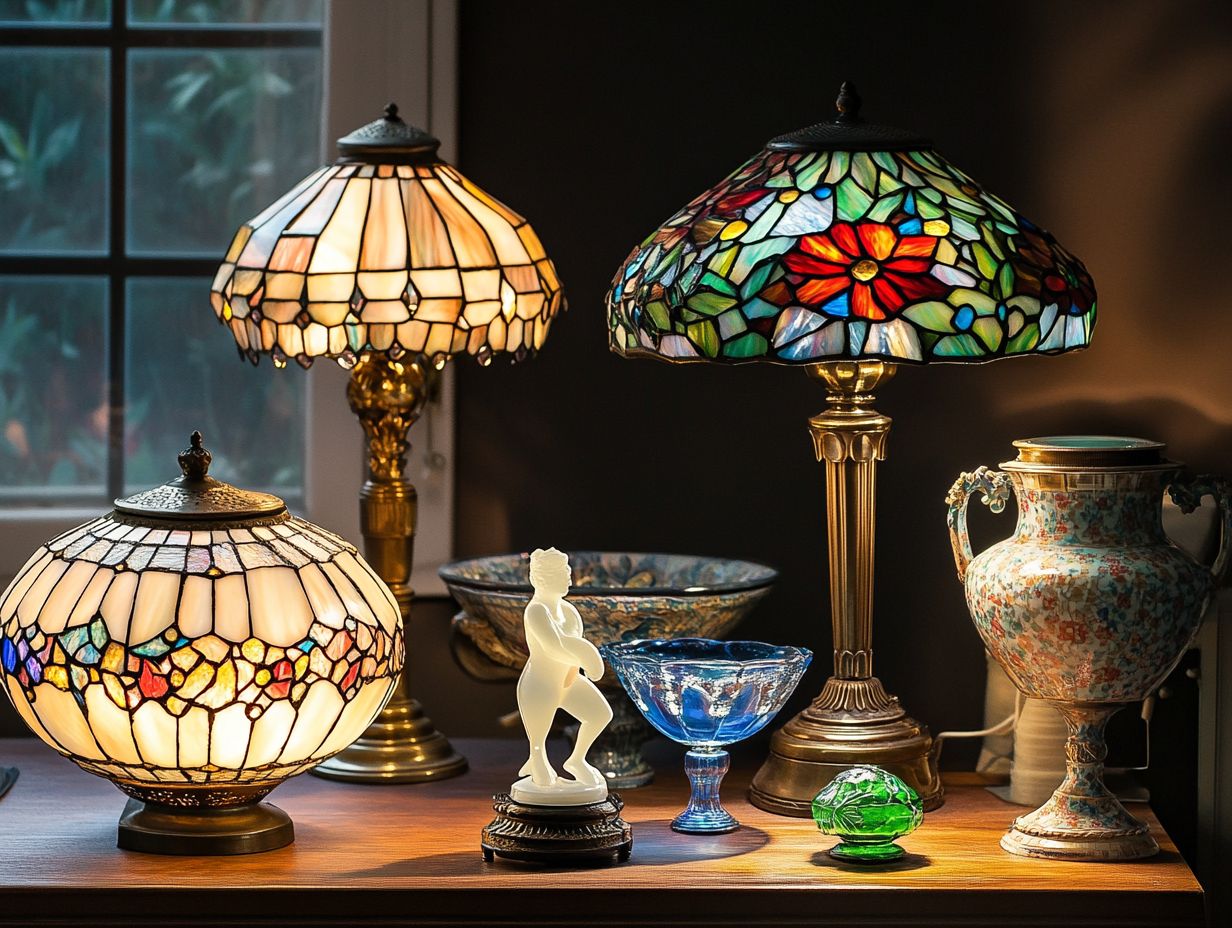
Ceramic is a sought-after material in vintage lamps, loved for its vibrant colors and intricate patterns that instantly elevate your space! This medium not only provides vintage authenticity through unique glazes and finishes but also serves as an exceptional canvas for designs that reflect various artistic movements.
When you choose ceramic for your light fixtures, you opt for a piece that is truly a work of art, showcasing techniques from delicate hand-painting to striking contemporary forms. Its versatility allows it to blend beautifully with styles from Art Deco to Mid-Century Modern, creating a seamless mix of functionality and artistry.
Ceramic diffuses light softly, enhancing the ambiance of any room. Its durability ensures that these lamps become timeless treasures. By incorporating ceramic elements, vintage lamps do more than simply illuminate spaces; they weave narratives that connect the past with the present in a visually captivating manner.
Wood
Wood has long been a beloved choice for vintage lamps, bringing a rustic charm and warmth that truly enhances their vintage allure. You ll find a variety of woods in play, from sturdy oak to rich mahogany. The quality of craftsmanship and intricate details of the woodwork significantly enhance each lamp’s unique aesthetic and character.
The natural grains and textures of these woods provide a tactile experience and reflect the artistry of their respective eras. They showcase how design principles have evolved over time. Historically, wooden vintage lamps often transcended mere functionality, becoming art pieces that connect families to traditions and craftsmanship passed down through generations.
Embracing wood in these fixtures adds a layer of storytelling. Every knot and imperfection contributes to their individuality. The delicate balance between the wooden elements and the lamp’s light source creates an inviting ambiance, ensuring these pieces remain timeless staples in both contemporary and traditional settings.
Other Materials
Beyond traditional materials, vintage lamps can embrace a delightful array of elements, such as fabric and resin, which infuse unique aesthetics and modern functionality into their design. These materials not only enhance decorative aspects but also play a pivotal role in restoring these historical treasures, ensuring they retain their charm and practicality.
For instance, when you opt for stained glass as a shade, it softens the light and creates captivating patterns and mesmerizing color play that can transform a space. Resin, often used in the base, brings both durability and an artistic flair, making it easier to replicate intricate designs that harken back to a bygone era.
Fabrics like silk or linen can elevate a lamp’s elegance, introducing textures and tones that enrich your decor. Collectively, these materials breathe new life into vintage lamps, allowing them to shine as both stunning decor pieces and functional light sources in modern settings.
Explore more about vintage lamps and consider adding one to your home!
Factors to Consider When Choosing a Vintage Lamp
When selecting a vintage lamp, several essential factors warrant your attention. This ensures the piece aligns with both your aesthetic vision and functional needs.
First, consider the lamp’s style and design. Styles can differ significantly across historical movements, from the elegance of Victorian to the boldness of Art Deco. It s also important to pay close attention to its condition and authenticity, as these elements are crucial for preserving its value.
Be sure to check that it works safely! By thoughtfully evaluating these aspects, you ll find quality craftsmanship and distinctive designs that will elevate any space.
Style and Design
When selecting a vintage lamp, the style and design are crucial. They significantly impact the lamp’s aesthetic appeal and historical significance.
You ll find vintage lamps in a variety of styles, such as Art Deco, known for its geometric designs and bold colors. Victorian styles are celebrated for their ornate details and romantic charm. Each style offers a unique aesthetic that can seamlessly complement your interior decor.
Mid-Century Modern lamps provide a sleek, minimalist vibe, making them a perfect match for contemporary furnishings. In contrast, Industrial designs introduce a rugged, utilitarian feel to your space. Each of these styles reflects the design movements of their time and evokes a sense of nostalgia.
This blend of history and artistry allows vintage lamps to resonate with modern sensibilities, making them versatile pieces that enhance various decorating themes. Whether they illuminate a cozy reading nook or serve as a statement piece in your living room, vintage lamps infuse warmth and personality into any environment.
Condition and Authenticity
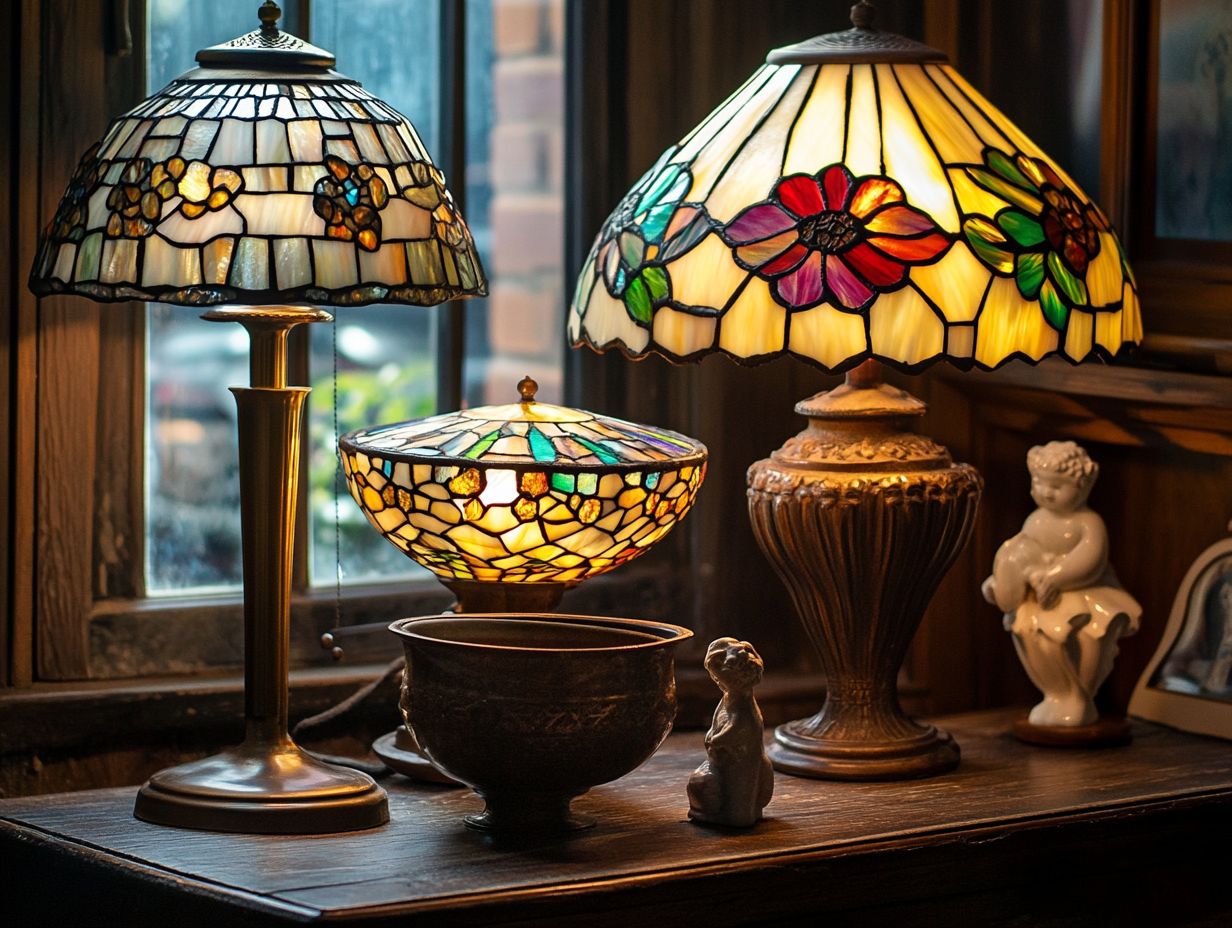
Evaluating the condition and authenticity of a vintage lamp is essential for you as a collector. This directly impacts the lamp’s value and desirability.
When identifying vintage lamps, you should meticulously consider factors such as craftsmanship quality, the presence of original parts, and the overall physical condition. Confirm that the piece genuinely represents its era.
Recognizing these features deepens your understanding as a collector and enhances your investment. Conduct thorough research on the manufacturer’s history and the distinctive style characteristics of that period. This background information will be invaluable in determining authenticity.
Carefully inspect the lamp for any signs of restoration or inconsistencies, as these can dramatically affect its value. Don t overlook original components like shades and fittings, as these details often reveal the lamp’s true heritage.
Seeking expert opinions or utilizing trustworthy market resources can further assist you in making informed decisions. Ultimately, this leads you to discover prized pieces for your collection.
Functionality and Safety
When selecting a vintage lamp, prioritizing functionality and safety is crucial. This is especially important if it s going to light up a modern space.
While vintage electric lamps can be stunning, it s essential to evaluate their wiring and electrical components. Confirm they meet today s safety standards while still delivering modern performance.
This meticulous assessment involves examining for frayed wires, outdated fixtures, and any signs of wear that could pose risks. As you choose your lamp, consider upgrading its components to incorporate contemporary features like LED bulbs.
Not only do these enhance energy efficiency, but they also boost illumination without sacrificing the lamp’s authentic charm. Striking a balance between aesthetic allure and practicality is key; the appearance that comes with age offers character, but it shouldn t come at the cost of safety.
Ultimately, ensuring that a vintage lamp operates safely within today s home creates a delightful fusion of classic elegance and modern functionality. Take the time to ensure your vintage lamp shines safely in your home!
Proper Care and Maintenance of Vintage Lamps
Proper care and maintenance of vintage lamps are crucial for preserving their beauty and functionality over time. Use specific cleaning techniques that honor the materials involved. For instance, gentle dusting is ideal for delicate glass, while the right polish for metal components enhances their shine.
Adhering to restoration tips helps ensure these vintage treasures remain in impeccable condition, highlighting their historical significance and quality craftsmanship.
Cleaning and Preservation Techniques
Cleaning and preserving vintage lamps is an art that requires attention to the materials involved. This allows these historical treasures to maintain their charm and functionality. Use gentle cleaning techniques tailored to each lamp component: think soft cloths for glass and suitable metal polishes for brass.
This approach ensures that the integrity and beauty of the lamp endure while steering clear of potential damage. Understanding vintage lighting wiring and the unique characteristics of materials like ceramic, bronze, or Tiffany glass can greatly enhance your preservation efforts.
Ceramic lamps benefit from a mild soap solution to lift dirt without scratching their surface. Bronze fixtures thrive under methods that maintain their aged look, accentuating their allure. Applying specific waxes and buffers on wooden bases not only protects the finish but also adds a delightful sheen.
Your choice of products and methods underscores the importance of authenticity and value preservation in vintage lighting. This ensures these exquisite pieces are cherished for generations to come. Understanding lamp anatomy and lamp characteristics also plays a significant role in their durability.
Frequently Asked Questions
What materials are typically used in vintage lamps?
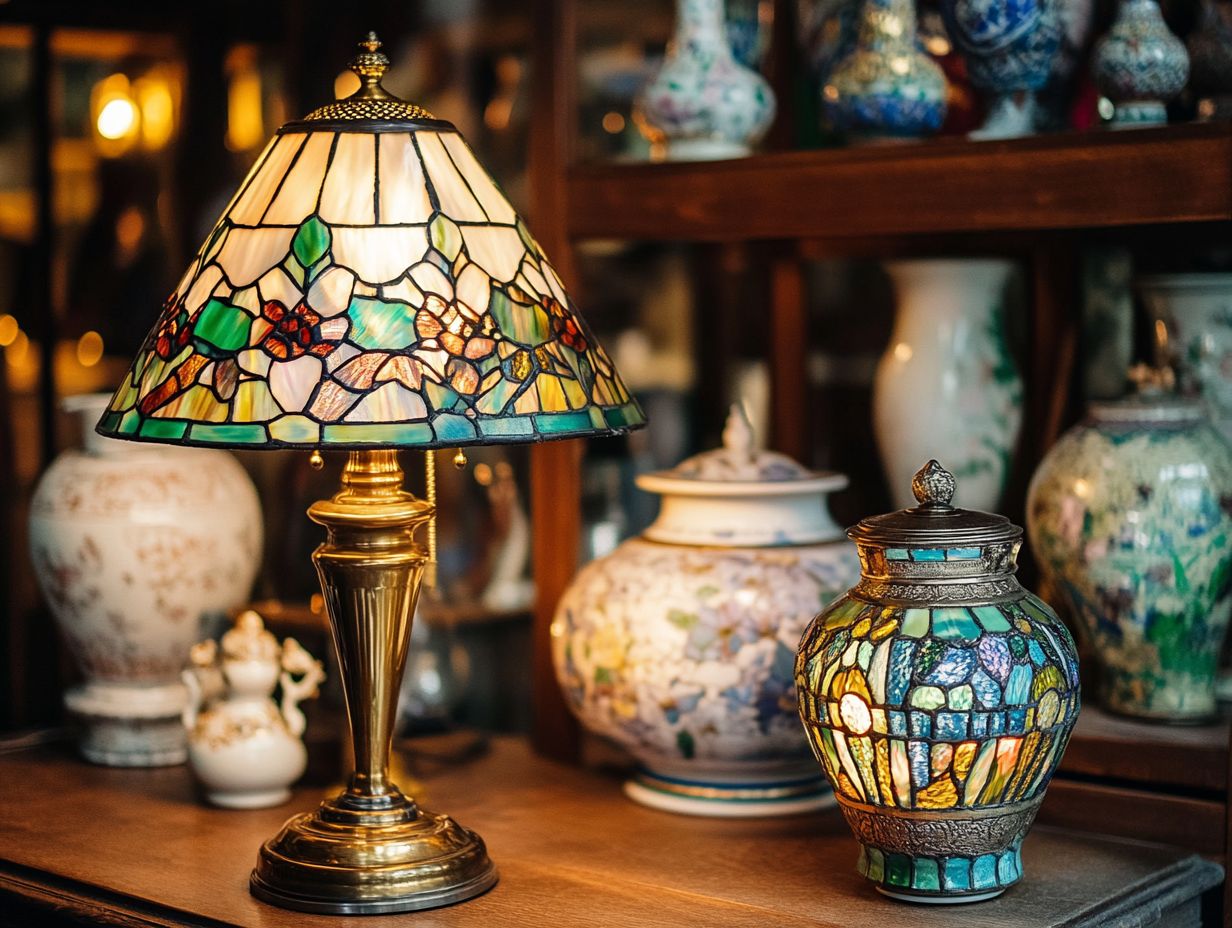
Vintage lamp materials include glass, metal, porcelain, and other materials commonly used before the 1980s.
How can I identify the material of a vintage lamp?
Look for markings or labels on the lamp itself. Examine the color, texture, and design to determine its material.
What are some common vintage lamp materials?
Common vintage lamp materials include brass, bronze, stained glass, and marble.
Can vintage lamp materials be used in modern lamps?
Yes, vintage lamp materials can be used in modern lamps. However, it is essential to consider the safety and functionality of the materials. Some may not meet current safety standards, so it’s best to consult a professional.
Do vintage lamp materials affect their value?
Yes, the materials used in a vintage lamp can affect its value. Rare or high-quality materials, such as hand-blown glass or solid brass, can significantly increase the lamp’s value and enhance its timeless beauty in your collection.
Why are vintage lamp materials desirable?
Vintage lamp materials add a unique and nostalgic touch to a space. They often feature intricate designs and craftsmanship that cannot be replicated in modern materials. This makes them essential for antique collectors seeking decorative elements and historical artifacts.
Explore and care for your vintage lamps to appreciate their beauty and history!

